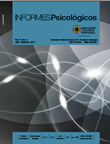Estructura Psíquica de un Grupo de Terapeutas Profesionales de Niños, Niñas y Adolescentes que han Vivido Experiencias de Abuso Sexual de la Ciudad de Medellín Colombia
Contenido principal del artículo
Resumen
Objetivo: describir la estructura psíquica de un grupo de terapeutas profesionales de niños, niñas y adolescentes que han vivido experiencias de abuso sexual (Grupo 1) en comparación con un grupo de terapeutas profesionales que no atienden este tipo de población de la ciudad de Medellín (Grupo 2). Método: Se partió de un enfoque cuantitativo no experimental, diseño transversal, con un alcance descriptivo comparativo. La muestra fue intencional por disponibilidad de sujetos, dividida en dos grupos: el grupo 1 (terapeutas de abuso sexual infantil) estuvo conformado por un 84% de mujeres y un 16% hombres y el grupo 2 (terapeutas que no trabajan abuso sexual infantil) por un 64% de mujeres y un 36% de varones (n=50, con 25 en cada uno de los Grupos). Resultados: en el Grupo 1 se encontraron correlaciones significativas entre estabilidad emocional y capacidad de trabajo, correlación media entre estabilidad emocional y distorsión de la imagen, capacidad de trabajo y distorsión de la imagen, seguridad en sí mismo y distorsión de la imagen. En el Grupo 2 se hallaron correlaciones medias entre estabilidad emocional y capacidad de trabajo, entre capacidad de trabajo y seguridad en sí mismo y una correlación significativa entre capacidad de trabajo y distorsión de la imagen. En la variable Distorsión de la Imagen se observó una diferencia significativa en la prueba de la mediana para muestras independientes. Conclusiones: Los análisis mostraron que no se observan diferencias estadísticas significativas entre los grupos objeto de estudio, excepto en estabilidad emocional y distorsión de la imagen, donde los terapeutas del Grupo 2, tienden a mostrar menores niveles de estabilidad y una imagen con un sesgo más negativo, esto es, una tendencia a mostrarse más autocríticos que los del Grupo 1.
Referencias
Castañeiras, C., Ledesma, R., García, F.O., & Fernández, H. (2008). Evaluación del Estilo Personal del Terapeuta: Presentación de una versión abreviada del Cuestionario EPT-C. Terapia Psicológica, 26(1), 5-13. doi: 10.4067/S0718-48082008000100001.
Caprara, G. Barbanelli, C., & Borgogni, L. (2007). BFQ Cuestionario ¨Big Five¨: Manual. 4 Edición. Madrid: TEA Ediciones S.A.
Coleman, D. (2006). Therapist–Client Five–Factor Personality Similarity: A Brief Report. Bulletin of the Menninger Clinic, 70(3), 232-241. doi: 10.1521/bumc.2006.70.3.232
Corbella, S., Balmaña, N., Fernández, H., Saúl, L., Botella, L., & García, F. (2009). Estilo Personal del Terapeuta y Teoría de la Mente. Revista Argentina de Clínica Psicológica, 18, 125-133.
Corbella, S., Fernández, H., Saúl, L., & Botella, L. (2008). Estilo personal del terapeuta y dirección de intereses. Apuntes de Psicología, 26(2), 281-289.
Engvik, H. (1999). Therapeutic popularity and personality: Association between peer therapist nominations and the “Big Five” Personality factors. Scandinavian Journal of Psychology, 40, 261-267. doi: 10.1111/1467-9450.404125
García, F., & Fernández, H. (2007). Investigación empírica sobre el Estilo Personal del Terapeuta: una actualización. Revista Argentina de Clínica Psicológica, 16(2), 121-128. doi: 10.4321/S0211-57352006000200002
Hossiep, R., & Paschen, M. (2006). BIP Inventario Bochum de Personalidad y Competencias: MANUAL. Madrid: TEA Ediciones S.A.
Hurt, A., Grist, C., Malesky Jr, L., & McCord, D. (2013). Personality Traits Associated with Occupational ‘Burnout’ in ABA Therapists. Journal of Applied Research in Intellectual Disabilities, 26, 299-308. doi: 10.1111/jar.12043
Instituto Colombiano de Bienestar Familiar (ICBF). (2010). Lineamiento Técnico para el Programa Especializado de Atención a: Niños, Niñas, Adolescentes Víctimas de Violencia Sexual con sus Derechos Amenazados, Inobservados o Vulnerados. Bogotá. Colombia.
Kessler, M., Nelson, B. S., Jurich, A. P., & White, M. B. (2004). Clinical Decision-Making Strategies of Marriage and Family Therapists in the Treatment of Adult Childhood Sexual Abuse Survivors. American Journal of Family Therapy, 32(1), 1-10. doi: 10.1080/01926180490255800
Lee, J., Wallace, S. Puig, A. Choi, B. Nam, S., & Lee, S. (2010). Factor Structure of the Counselor Burnout Inventory in a Sample of Sexual Offender and Sexual Abuse Therapists. Measurement and Evaluation in Counseling and Development, 43(1), 16–30. doi: 10.1177/0748175610362251
Machado, P., Beutler, L., & Greenberg, L. (1999). Emotion Recognition in Psychotherapy: Impact of Therapist Level of Experience and Emotional Awareness. Journal of Clinical Psychology, 55(1), 39-57. doi: 10.1002/ (SICI) 1097-4679(199901)55:1<39: AID-JCLP4>3.0.CO; 2-V
Pack, M. (2011). Discovering An Integrated Framework For Practice: A Qualitative Investigation Of Theories Used By Social Workers Working As Sexual Abuse Therapists. Journal of Social Work Practice, 25(1), 79-93. doi: 10.1080/02650533.2010.530646
Parga, M. X., Fidalgo, M. M., Elvira, A. C., & Sancho, E. R. (2011). Aproximación al estudio funcional de la interacción verbal entre terapeuta y cliente durante el proceso terapéutico. Clínica y Salud, 22(1), 69-85.
Rial, V., Castañeiras, C., García, F., Gómez, B., & Fernández, H. (2006). Estilo personal de terapeutas que trabajan con pacientes severamente perturbados: un estudio cuantitativo y cualitativo. Revista de la Asociación Española de Neuropsiquiatría, 26(98), 191-208.
Rodríguez, M.J., & Arias, S. (2013). Autocuidado en terapeutas: estableciendo un buen vínculo con pacientes considerados difíciles. Revista Sul Americana de Psicología, 1(2), 216-234.
Saarnio, P. (2010). Gender: Therapists Big Five Personality Traits and Interpersonal Functioning in Female and Male Substance Abuse Therapists. Substance Use & Misuse, 45, 1463-1473. doi: 10.3109/10826081003749963
Samios, C., Rodzik, A. & Abel, L. (2012). Secondary traumatic stress and adjustment in therapists who work with sexual violence survivors: the moderating role of posttraumatic growth. British Journal of Guidance & Counselling, 40(4), 341-356. doi: 10.1080/03069885.2012.691463
Szmulewicz, T. (2013). La persona del terapeuta: eje fundamental de todo proceso terapéutico. Revista Chilena de Neuro-psiquiatría, 51(1), 61-69.
Velásquez, M. Delgadillo L. & González, L. (2013) Abuso sexual infantil, técnicas básicas para su atención. Revista Reflexiones, 92(1), 131-139.


